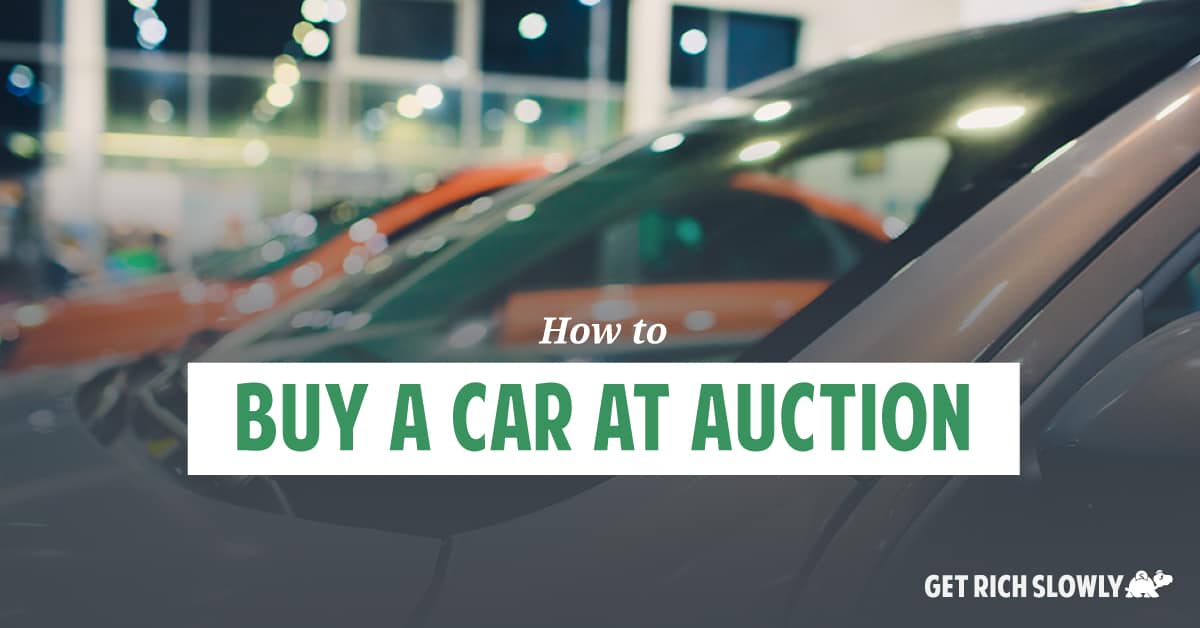How to buy a car at auction

This article written by Jacq is part of the “reader stories” feature at Get Rich Slowly. Some stories contain general advice; others are examples of how a GRS reader achieved financial success — or failure. These stories feature folks from all levels of financial maturity and with all sorts of incomes.
Woot! I just bought a new-to-me SUV at the local auto auction. It’s a 2008 Mitsubishi Outlander XLS 4WD and is loaded. I don’t think I’ve ever been in a car that’s this loaded! Well, maybe I have — but definitely not one of my own. And it’s red with a black leather interior. How fun is that?
As you can tell, I’m super excited since:
-
- Sharing a car with my son has been a pain, even if it’s been a money saver (for him more than me).
- It’s been so very long since I’ve owned a vehicle that I’ve been crazy about. A Yaris may be cheap and have great fuel efficiency, but let’s face it, it’s not the most fun vehicle to drive.
Best of all, my new Outlander came in at $10,000 (yay!) at auction. Blue book value in Canada for this model is around $20-22,000. Add the sales tax and the maximum dealer fee of $400, and the total came to just under $11,000.
Last year, Nicole shared a great reader story about how to buy a new car at a dealership. But I hate bargaining. I don’t like it even remotely. Plus, I don’t really care if a car is brand new or not. I just want reliability — and a little bit of style. Besides, after reading Get Rich Slowly for so long, maybe I’ve become too cheap to go for a new vehicle.
This video shows what goes on at an auto auction.
How to Buy a Car at Auction
Buying a vehicle at an auction can be fun, but not a lot of people are familiar with the process. Since I’ve done it, let me share the steps it takes to buy a car at auction.
- Find an auction that sells newer cars where the public is allowed to attend. Most auto auctions are run for dealers only, but some are open to the public. Vehicles at an auction are generally ex-rentals, off-lease, repossessions, or government vehicles. Mine was a trade-in being sold by a dealership. A quick google search for “your area or city + public + auto auction” should do the trick to find an auction in your area.
- Look at the inventory listing and pick a few vehicles that you really like. In this particular auction, there were 116 vehicles listed and several that I really liked. I knew that three of them would be out of my price range. (One was a Porsche Cayenne that sold for $49,200, and another was a BMW SUV. A girl can dream, can’t she?)
- Check out the vehicles at the auction house. There should be a pre-viewing session for the auction the day before. At the pre-viewing, you can start the vehicle but you can’t test drive it. (Although my son did accidentally put a car in drive and move it a few inches. He was so embarrassed, he thought they were going to kick him out.) Do all the things you ordinarily would when buying a used car: check underneath for fluid spills, pop the hood, bring a friend that knows more about cars than you do.
- Do your due diligence on handful of vehicles you want. Check out nadaguides for the (U.S.) book value, auto123.com for the best (Canadian) reviews. Check out auto forums on your selected models for personal experiences.
- Establish your base price for what you’re willing to pay. In my case, I was willing to go to $12,000 on the Outlander, but I was firm about that ceiling. (I think I would have got it for $7,500 if this one guy would have backed off. Oh well.)
- Ideally, go to one or two auctions just to get a feel for how the bidding goes. Usually they’ll start off with a fairly high number stated by the auctioneer. Do not jump in then. In my case, nobody was putting out the first bid for a couple of minutes — which felt like hours — and the auctioneer finally asked for a starting bid. I put out $5,000 to start. In hindsight, I wish I hadn’t because it seems like the first one to open their mouths always loses. But if there’s no starting bid, the auctioneer will let the vehicle go without bidding since they’re moving through these vehicles at a rate of about 15 per hour. I didn’t want to lose this baby.
- Watch the mood and trend of the crowd in the bidding before your vehicle comes up for sale. I’ve noticed that at auctions there are frugal crowds and there are spendy crowds. I don’t know why this is. I’ve seen furniture, tools, and kitchen cabinets sell for 10% of retail. But I’ve also seen them sell at what you’d pay for full retail in a store at the same auction house on different days. There doesn’t seem to be any rhyme or reason to it. Always be prepared to walk away. There’ll be another auction in a week or two.
- Stick to your guns on your price. Really. It’s easy to get caught up in the bidding at an auction. It’s almost like they can put you into a suggestible hypnotic trance state.
- Get an inspection done at the auction house, if it’s available. That’s a Buyer Protection Plan for major components. In my vehicle’s case, that cost $80. If there’s anything wrong, you can go into arbitration and the seller can lower the price or you can choose not to take the vehicle.
If you buy a car at auction, you have to put a deposit down on the day of sale. You then have to make full payment on the next business day.
Here are some final selling prices from other vehicles at this auction. I left as soon as I bought, so I never did find out how much the BMW SUV sold for. (Maybe I don’t want to know.)
- 2003 PT Cruiser: $1,500
- 2010 Dodge Grand Caravan: $13,400
- 2005 Hyundai Sonata: $4,900
- 2007 Ford Escape XLT: $9,300
- 2009 GMC Yukon SLT: $25,300
- 2001 Ford Windstar SEL: $2,550
- 2008 Chev HHR LS: $3,000
- 1997 Jeep Grand Cherokee: $800
- 2000 Dodge Grand Caravan: $1,425
- 2008 Ford Escape XLT: $11,400 (Ha! My Mitsy is WAY nicer than that!)
- 2011 Chev Impala LS: $10,250
- 1999 Honda CR-V LX: $2,000
- 2006 Ford F250SD Supercab XLT: $7,000
- 2006 Ford F350SD LWB XLT: $10,000
- 2006 Ford F350SD LWB XLT: $12,500
- 2006 GMC Sierra 1500 4WD SLE: $6,100
- 2002 Ford Thunderbird Convertible: $12,250 (gorgeous – my son drooled over this one)
- 2010 Dodge Grand Caravan: $8,000
- 2006 Lincoln Navigator Utility: $15,100
- 2007 Dodge Charger: $4,700
- 2007 Jeep Commander Utility: $9,100
- 2007 Saturn Aura Hybrid: $13,000
- 2008 Pontiac Solstice Roadster: $8,000 (sexy car, but totally impractical)
- 2000 Chrysler 300M: $3,700
- 2008 Jeep Compass: $5,100
- 2006 Infiniti M45: $14,200
- 2004 F150 XLT 4×4: $3,000
- 2006 Chev Cobalt Coupe LT: $3,900
- 2008 Porsche Cayenne Utility Turbo: $49,200 (ay carumba)
- 2010 GMC Acadia Utility AWD: $25,100
- 2010 GMC Acadia Utility AWD: $24,100
The prices for some of these vehicles may seem high (and some of them really aren’t a good deal anyway) since it’s Canadian pricing which is somewhere around maybe 20% higher in Canada than the U.S. But it also shows that unless you do your due diligence on the vehicles, you really might not get a good deal. There’s no guarantee.
This almost makes me want to start a side business flipping cars. (Almost.)
I’m happy with my purchase, and I’d encourage other GRS readers to explore this as an option when buying a car. For me, the only thing left — besides paying for the vehicle with a money order — is deciding what to call her. Mitsy? Outie?
Become A Money Boss And Join 15,000 Others
Subscribe to the GRS Insider (FREE) and we’ll give you a copy of the Money Boss Manifesto (also FREE)


